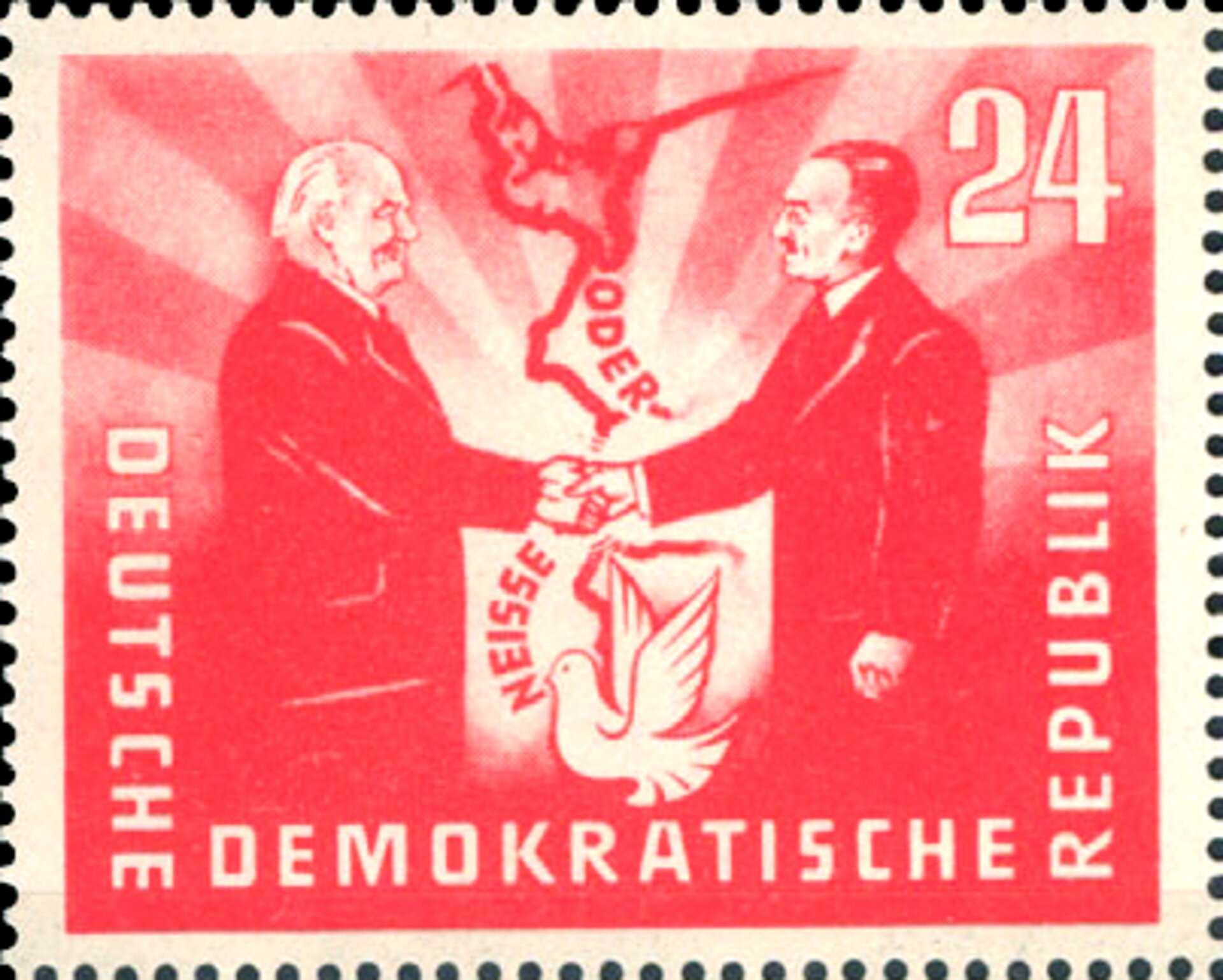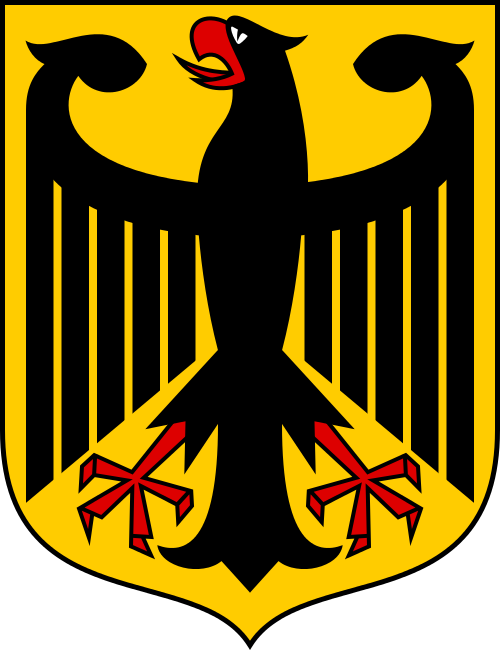Two German states
how the two German states were created after the war;
how the Warsaw Pact was created;
about the differences between West Germany and East Germany.
After lost war, the German state was divided by the allies into French, British, American and Soviet occupation zones. They were controlled by the Allied Control Council for GermanyAllied Control Council for Germany (1945) – the highest legislative and administrative body of Germany. However, it soon appeared that there are many disputable issues between the Western States and the USSR concerning the future of Germany.
In the Soviet zone, changes were implemented according to the ones in the Soviet Union – the industry, commerce and banks were nationalisednationalised, and the agricultural reform was carried out. The Western States found these steps to violate the agreement and started the process of unification of the German lands under their supervision. In 1947, the British and the American zones were combined together (Bizone), and in 1949 the French zone joined them (Trizone), which was followed by democratic elections to the parliament. In 1949, with the consent of the powers, the parliament announced the establishment of the Federal Republic of Germany (FRG). Its first chancellorchancellor became Konrad Adenauer. In response to this development, the German Democratic Republic (GDR) was created of the Soviet zone in October 1949. It was fully subordinate to the will of Stalin and to his decisions.
In 1955, the FRG, which so far had been supervised by the allied states, was recognised as a sovereign state, the same becoming eligible to join NATO and the Council of Europe. In response to the accession of Western Germany to the military alliance, the Warsaw PactWarsaw Pact was created 1955. Its official task was to defend the socialist countries against the threat posed by the American imperialism.
The paths of development of the FRG and the GDR were completely different. Thanks to the financial support (i.a. the Marshall PlanMarshall Plan, West Germany (FRG) quickly became a competitive economy, which resulted in high standard of living of its citizens. On the other hand, dependent on the Soviet Union, relying on the Soviet model of planned economyplanned economy, and deprived of democracydemocracy and freedoms GDR remained a poor and economically underdeveloped state, similar to other Eastern Bloc states. A major problem for this state was posed by the escapes of its residents to the FRG, especially in divided Berlin. To remedy this situation, a wall was built that divided the two parts of the city in just one night of 15/16 August 1961.
In 1966, Chancellor Willy Brandt started a new policy. Direct relations were established with the eastern neighbour, the Eastern Bloc States, and then the USSR. The result was the admission of both German States to the UN. Also the borders of Poland on the Oder and the Lusatian Neisse Rivers were recognised. For his political achievements, the German Chancellor received the Nobel Peace Prize in 1971.
The breakthrough for the two states was the takeover of power by Mikhail Gorbachev in the USSR and the transformation in Poland in 1989. These events led to the fall of the communism in Europe and the disintegration of the old divisions of the World. In the result conditions were created for the reunification of Germany. Its godfather was the Chancellor of FRG, Helmut Kohl, who finally led to the establishment of a single German state on 3 October 1990.
Say, what characters and symbols are refered to by the stamp issued on the anniversary of the creation of GDR.

Compare the symbols of both countries. Specify differences and similarities. What were the differences?
Match terms to definitions.
deliberate actions aimed the propagation of specific behaviours and views, limitation of the freedom of speech consisting in verification of information and publication of only this information, which is consistent with the point of view of the authorities, a political and military alliance established in 1955 by the Eastern Block. The dominated role was played in it by the USSR, takeover of private property, companies and capital by the state, the name of the prime minister in Germany and Austria, the post-war world and its division into the zone of influence of the democratic states (in the West) and the USSR (in the East), the programme of rebuilding of European economies after World War II by provide material and financial aid, as well as investments to destroyed by war Europe, a political system and system of government, in which the will of the majority of citizens expressed in independent elections is the source of power
| Nationalisation | |
| Democacy | |
| Marshall Plan | |
| Propaganda | |
| Censorship | |
| Warsaw Pact | |
| Chancellor | |
| Iron Curtain |
Keywords
Nationalisation, democracy, propaganda, censorship, Warsaw Pact, chancellor, Iron Curtain
Glossary
Sojusznicza Rada Kontroli – urząd powołany do życia po kapitulacji Niemiec w maju 1945 r., w skład którego wchodzili przedstawiciele zwycięskich mocarstw – Wielkiej Brytanii, USA, ZSRS oraz Francji. Był najwyższym organem prawodawczym i administracyjnym działającym na terenie okupowanych Niemiec. Jego powołanie przewidziano na konferencji w Jałcie w lutym 1945 r.
Nacjonalizacja – inaczej upaństwowienie, przejęcie przez państwo majątków, przedsiębiorstw i kapitału prywatnego.
Demokracja – ustrój polityczny i system sprawowania władzy, w którym jej źródło stanowi wola większości obywateli wyrażona w niezależnych wyborach.
Plan Marshalla – program odbudowy gospodarek Europy po II wojnie światowej zaproponowany przez Stany Zjednoczone w 1947 roku. Jego celem była pomoc materialna (surowce, żywność), finansowa i inwestycyjna dla zniszczonej wojną Europy. W wyniku nacisków rosyjskich, nie przystąpiły do niego kraje będące pod wpływem ZSRS.
Propaganda – celowe działania, które mają doprowadzić do określonych zachowań i poglądów. Służy ona do upowszechnienia dogodnych informacji dla nadawcy. W języku potocznym synonim kłamstwa i manipulacji.
Cenzura – kontrola i ograniczanie wolności słowa polegające na weryfikacji i przekazywaniu tylko zgodnych z punktem widzenia władzy informacji. Występuje najczęściej w krajach niedemokratycznych i czasie konfliktu zbrojnego.
Gospodarka planowana – system gospodarczy, w którym decyzje dotyczące produkcji i inwestycji podejmowane są przez władze centralne w postaci planów gospodarczych. Najczęściej występuje w okresie wojny oraz w krajach socjalistycznych. Jest przeciwieństwem wolnego rynku.
Nagranie dostępne na portalu epodreczniki.pl
nagranie słówka: Council for Mutual Economic Assistance (CMEA)
Rada Wzajemnej Pomocy Gospodarczej (RWPG) – międzynarodowa organizacja gospodarcza państw socjalistycznych istniejąca w latach 1949–1991.
Układ Warszawski – sojusz polityczno‑wojskowy utworzony w 1955 r. przez blok wschodni. Dominującą rolę odgrywał w nim ZSRS. Oficjalnie miał charakter obronny, w rzeczywistością był odpowiedzią na rozszerzenie NATO o RFN i przeciwwagą dla zagrożenia ze strony Paktu. Istniał do 1991 r.
Kanclerz – nazwa stanowiska premiera w Niemczech oraz Austrii.
Żelazna kurtyna – określenie zastosowane przez Winstona Churchilla, a następnie spopularyzowane, określające kształt powojennego świata i jego podział na strefę wpływów państw demokratycznych (na Zachodzie) i ZSRS (na Wschodzie).
Blokada Berlina – jeden z pierwszych poważnych kryzysów powojennych z lat 1948–1949, do którego doprowadziła blokada zachodnich sektorów podzielonego Berlina przez wojska radzieckie. Zaopatrzenie do alianckich części miasta dostarczano utworzonym mostem powietrznym.

